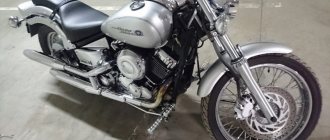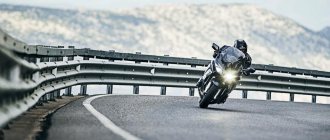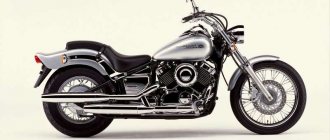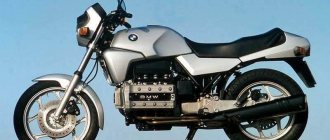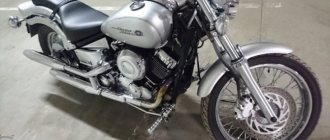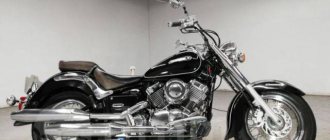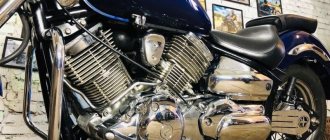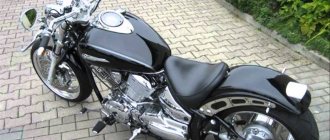Advantages of a motorcycle
There aren't many motorcycles out there that don't have a family bug, and the Drag Star is one of them. The secret to the reliability of this model is technical solutions as simple as a hammer. Editorial bike!
The first advantage you should pay attention to is the appearance of the bike. Its laconic, but at the same time attractive design looks very cool on the road.
High reliability is also an advantage
It is simply impossible to overheat the power unit, since it is air cooled. The engine is serviced as simply as possible, since the motorcycle does not use electronics or an injector. But you also don’t have to worry about the quality of gasoline; the cruiser has a good fuel filter.
Incredibly convenient and comfortable due to the soft suspension. You can sit comfortably in the seat and travel for a long time. Wide wheels will allow you to overcome bad and uneven roads without problems, and large fenders will save you from splashes and dirt.
The cruiser is lightweight for its size. It is convenient to move around the city, and in order to stop in traffic jams, you just need to stick your foot out. Many owners claim that when they were drifting on a bike, they tried to make a large angle of inclination at which the motorcycle could fall. But with your leg out, it is very easy to hold it and this is one of the main advantages.
Servicing a motorcycle is a pleasure. There are no such problems as with sports bikes, which need to remove a large number of elements. Spark plugs, oil and oil filter are very easy to change. Difficulty can only arise when replacing the fuel filter. But this is not a drawback, since this consumable changes very rarely, and, for example, it can be replaced at the moment when the carburetor is cleaned.
and disadvantages
Now let's look at what the disadvantages are.
- The most significant disadvantage is the lack of a fuel level indicator. Any self-respecting motorcyclist simply cannot do without this device. The bike may only have a light on when the system switches to reserve fuel.
- Before you ride your motorcycle, you need to warm it up properly. It will not run on a cold engine, like an injector. If you try to ride without warming up, the motorcycle will jerk and there will also be dips. It is unlikely that this will bring pleasure while moving.
- Some motorcyclists may find it insufficient that the transmission has only 5 ranges. Many people believe that in sixth gear, fuel was consumed economically when traveling at high speeds.
Yamaha XVS650 Drag Star: Review and test from Behind the Wheel magazine
Mid-sized cruisers are not particularly popular among domestic chopper drivers, and they, having saved money, with the words “anything less than a liter is not a chopper,” are switching from their first “four hundred” to “one and a half liters” and more. The middle segment remains the lot of young ladies and “pensioners,” but in vain.
STORY . Yamaha XVS650 Drag Star became the successor to the “honored witch of all Japan” - XV535 Virago in 1997. Unlike its predecessor, the Star was no longer a timid attempt to make a motorcycle in the American style - the Japanese had already accumulated experience in creating this kind of equipment. Low, elongated frame, rear suspension a la “softail” with a monoshock absorber hidden in the depths of the frame, teardrop-shaped tank, stepped saddle, tidy on the tank, a lot of chrome... In general, you can’t complain. But the engine on the “drag” is already familiar: a 75-degree four-valve V-twin from the same “Viraga”, only slightly modernized in appearance and “grown” to 649 “cubes” due to an increase in cylinder diameter by 5 mm and by 4 - piston stroke. With the same compression ratio of 9:1, the updated engine has become more “chopper-like”, that is, less revving, but more torquey. Compared to the Virago, the power even decreased from 42.3 hp. at 7500 rpm up to 40 hp. at 6500 rpm, the torque, on the contrary, increased, and its peak “fell” by as much as “half a tachometer”: from 46 Nm at 6000 rpm to 50.9 Nm at 3000 rpm.
Otherwise, there are no high-tech and modernistic trends alien to cruisers: a disc brake in the front, a drum in the rear, a carburetor power system, which, by the way, has not yet been replaced with injection, and other technical solutions that are simple and reliable as a hammer. The motorcycle created according to this simple “recipe” turned out to be extremely reliable, comfortable, easy to operate and maintain and, of course, got its own piece of the consumer “pie”, which it is still “chewing” to this day. True, this happens mainly not in Russia, but in countries where motorcyclists suffer from “lithromania” in a less advanced form.
FOR WHAT? Conversations about the purpose of any cruiser always end in controversy. Fans extol the comfort and relaxation of the landing; opponents point to the weakness of the engines, the weakness of the chassis and the inconvenience of maneuvering in city traffic. Both are true, but in relation to the Drag Star 650, all arguments are only partially applicable. Although 40 “horses” look rather dull, in fact they “carry” a 225-kilogram motorcycle quite vigorously. The low center of gravity of the motorcycle itself and the rather low saddle (695 mm) make it easy to shift the motorcycle in turns and not only for “big pot-bellied guys,” but also for petite girls to feel confident in the grip of traffic jams. By the way, it is precisely thanks to this feature that in Russia “drag” is so popular among the fair sex. It looks large and “cast iron”, but in reality it is a light and obedient device. It is precisely due to its light weight, low center of gravity and relatively compact dimensions that the 650 feels much more at ease in the city than all kinds of VTX, Boulevard and other “mastodons”. The device is also quite good as a route tool. A relaxed landing, soft suspension and excellent directional stability make long-range driving quite comfortable, although not fast.
WHERE TO LOOK? There are plenty of offers for sale, both from private owners selling devices that have already traveled around Russia, and from companies transporting equipment “from there”. “drag” can be found in almost any salon selling second-hand goods. Unlike most entry-level and mid-level models, the vast majority of dragstars are in fair, and often truly perfect, condition. The reason for this is the reliable design and the almost complete ignorance of the model by beginners. So you shouldn’t avoid vehicles with mileage in Russia. It’s quite difficult to come across blatant trash. Moreover, a device from “Russian” hands can be a more profitable purchase than one freshly imported from Japan or the States. The technical condition may be no worse, and the price may be more attractive. The price range for motorcycles is quite wide. From 170–195 thousand rubles. for copies of the first years of production up to 300–320 thousand rubles. for almost new one-year-old - three-year-old specimens. In part, the price depends on the amount of tuning, but, as a rule, the bulk of the devices have a similar set: panniers, a windshield, arches and various “tchotchkes” that do not affect speed and comfort. So you shouldn’t consider the presence of any of the above as a serious reason for raising the price. There should be no issues with selling a used device. There is always a stable demand for it. Naturally, taking into account cruiser specifics. Unlike enduro or even 400 classics, appearance for a custom car is far from the last thing, so traces of falls, scuffs and scratches on chrome and paint seriously reduce both the marketability of the device and its price. It will be difficult to sell the motorcycle at the end of the season. Potential buyers of the “drag” are most often people of average income and by the end of the season are not burdened with an extra two hundred thousand rubles. And a chopper is not an enduro to buy in winter.
WHAT TO WATCH FIRST AND WHAT TO FOLLOW LATER?
(+) From a technical point of view, the motorcycle can be classified as practically problem-free. There are not many motorcycles without “family diseases”, and the Drag Star is one of them. There are several reasons for this. Firstly, the refined design of the engine and transmission, which is based on the Virago power unit, is simple and long ago “cured” of all infantile shortcomings. Secondly, the relative freshness of the model and far from exorbitant popularity. The device very rarely reaches people with crooked hands and a hot head. So all checks when choosing a motorcycle can be reduced to a standard diagnostic list: timing noise, freshness of consumables, tightness of shock absorbers and checking frame geometry. By the way, the system for adjusting timing valve clearances here is a common one - a screw-nut, so there will be no difficulties with adjustment.
(+) Unlike the older model XVS1100 Drag Star, the “six hundred and fifty” is practically not subject to slipping of the starter overrunning clutch, so a slightly different design is used here, but even if the defect does come out, the part costs half as much as the similar one from the 1100.
(!) The design of the average “drag” is almost identical to the internal Japanese “400” (only the size of the cylinders, gearbox ratios and other minor details differ), so you can extrapolate some of the defects of the “400”. Since there are many more of them in Russia, more extensive statistics have been collected on them. So, sometimes on the XVS400 the driveshaft breaks, the starter overrunning clutch fails, and the voltage regulator relays burn. However, all these defects can be attributed not to the weakness of the design, but to improper operation and lack of timely maintenance of the equipment. In general, if the motorcycle has not been damaged by its previous owners, then with proper care it will work without problems for many years.
WHAT TO BUY? Advising something specific from tuning a cruiser is a thankless task. As they say, all markers are different in taste and color. Numerous aftermarket catalogs offer every imaginable and inconceivable bells and whistles for a dragstar, from caps on wheel nipples to complete exhaust kits, Dinojet kits for carburetors, from gel seats to designer rims. In a word, the tuning possibilities are limited only by a sense of proportion, taste and the thickness of the owner’s wallet. The only things that can be classified as very desirable body kits are crash bars and a windshield, although both are already installed on the vast majority of vehicles sold.
Source: magazine "Behind the Wheel"
Go to Yamaha Drag Star/V-Star 650 (XVS 650)
- Read review Yamaha Drag Star/V-Star 650 (XVS 650)
Main modifications of the Yamaha Drag Star 650:
Yamaha Drag Star / V-Star 650 Custom - basic version of the motorcycle - short fenders, thin front wheel.
Yamaha Drag Star / V-Star 650 Classic - version with extended fenders, a wider front wheel, a headlight without a visor, foot platforms (instead of pegs), a wider seat and a different handlebar shape.
Yamaha Drag Star / V-Star 650 Silverado - Classic version with touring body kit - high windshield, leather bags, passenger seat back and exclusive trim style.
Since 2014, the Yamaha XVS650 V-Star has only been available in the US market and is currently only sold in Canada.
conclusions
The Yamaha Drag Star 650 is a real “steel horse” that appeals to many bikers and is still popular today.
Despite the engine being rather weak by modern standards, the motorcycle accelerates well, and at speeds up to hundreds it is almost as good as more powerful choppers.
The solid appearance with numerous chrome elements can attract thousands of glances. Good stability will allow you to move without problems on any road surface. The cost of a motorcycle starts from 170 thousand rubles.
What do the owners say?
This is not the cheapest motorcycle, but it is still more affordable than many when compared with current options,
And, judging by the reviews of the owners, this is important for many. However, many bikers believe that it is better to buy a more expensive but more reliable bike
However, opinions on this matter vary. And there is a reason for this. On the one hand, the car is still in production, and therefore there are no problems with spare parts and maintenance. On the other hand, the bike has a drum as a brake at the rear, an outdated solution that is considered dangerous by today's standards.
One owner review shows the car to handle medium speeds just fine. However, there is not a word about braking. When buying such a bike or any other with a drum brake, you should first make sure that the brake is working properly.
This technique, as described by many owners, is not bad for short pleasure trips. However, this cruiser is still not suitable for the role of a motorcycle for long distances. Maybe in videos and photos this car looks reliable, but in practice there are much more worthy representatives of the class in this regard.
In conclusion, it is worth noting that the Yamaha XVS 650 Drag Star is a bike that is primarily suitable for connoisseurs of old representatives of this class. Others are unlikely to be interested in him. It is better for a beginner not to ride such a vehicle at all, since this bike will not be easy even for those who are accustomed to cruisers, but modern ones.
Dimensions and weight
This bike is average in size in its class. Larger than any representative of road motorcycles, it is nevertheless inferior to many cruisers. For example, models released at the beginning of this century are larger than motorcycles.
The dimensions of the Yamaha XVS 650 Drag Star are as follows:
- curb weight – 227 kg;
- seat height – 695 mm;
- ground clearance - 155 mm;
- wheelbase – 1610 mm;
- height – 1065 mm;
- width – 880 mm;
- length – 2295 mm;
- tank volume – 16 l.
Considering the average size of the bike, the tank volume is sufficient. Of course, such a car is not suitable for traveling outside civilization. Moreover, given the minimum ground clearance and the class itself, driving on rough terrain is not a suitable option.
Video
Yamaha XVS 650 Drag Star
, also known as the V-Star 650, is a prominent representative of mid-sized cruisers. Produced for ten years, this motorcycle has won a whole army of fans, like its 400 cc and 1100 cc brothers in the model line. The combination of style, low price, proven reliability and the size of a full-fledged chopper appeals to many bikers.
The Yamaha Drag Star 650, in terms of its characteristics, occupies an intermediate niche between 400 cc and “almost liter” motorcycles. Its V-shaped air-cooled twin with 2 valves per cylinder produces 40 horsepower. Two carburetors and a rock-solid driveshaft complete the picture. This is the embodiment of a classic of the Japanese school of cruisers. Of course, the appearance, so classic and painfully familiar, is inspired by the American Harley-Davidson. But this is the case when the follower is no worse than the original - in its class, of course. And if someone does not have the opportunity or desire to ride a large motorcycle, then the Drag Star 650 would be an excellent choice.
However, if we talk about physical dimensions, then everything is fine. The Yamaha Drag Star 650 is the exact same size as the 400cc version, but is a full-size bike that will be comfortable for most people, except the very tall ones. And in general, there are few differences between the 650 and 400 versions - the electrical circuit, the CPG and small body kit elements, such as the air filter cover. Otherwise, the parts of these motorcycles are interchangeable.
The gas tank of the Yamaha XVS 650 holds 14.5 liters. Consumption varies from 4 liters during quiet driving on the highway to 6.5-7 liters in the city. Yamaha prefers to consume gasoline with an octane rating of at least 92. The braking system is similar to that installed on the Drag Star 400 - one brake disc at the front and a drum brake at the rear. The rear brake is auxiliary, while the front one copes with its function quite well, although installing reinforced brake hoses will still not be superfluous.
One of the old-school styling elements is the gas tank-mounted instrument panel. It reads well and is intuitive, but if there is a windshield, glare from the dashboard at night can sometimes be a bit annoying. However, these are minor things. In other ways, like this, the Drag Star 650 is the epitome of a classic cruiser. An abundance of chrome, a V-shaped engine that growls very pleasantly (with direct-flow mufflers instead of standard pipes, of course), as if it had not 650 cubic meters, but about a liter and a half...
You can, of course, say that the Yamaha XVS 650 is a motorcycle without any special features. That’s how it is, in general. But this motorcycle is loved for something else - for its proven reliability, balance of all parameters and versatility. You can either drive it to work and back, or go on a trip, taking a passenger with you. You can ride in the evenings from bar to bar, or you can turn it into some incredible custom, fortunately the simplicity of the design of the Yamaha Drag Star 650 does not prohibit this. And, believe me, it’s not for nothing that this motorcycle has so many fans. Oh, not in vain...
Video
- A brief look and sound of the Yamaha Drag Star 400 Classic motorcycle.
- Review of the Yamaha Drag Star 400 Custom motorcycle.
Yamaha XVS 400 Drag Star
is a very popular motorcycle among beginner chopper riders. The reliability of the Drag Star line has already become a legend, and in general, Yamaha is not in vain considered one of the best motorcycle manufacturers in the world - they don’t do nonsense at the factories of this company. And the youngest from “Drag Stars” is an excellent confirmation of this.
This bike looks just like an adult, full-size chopper. And in fact, of all 400 cc motorcycles in this class, it is one of the largest, which makes it convenient for most motorcyclists. This motorcycle was produced in two versions, like its older brothers in the model line - Classic and Custom. You can read about the differences between these versions of Drag Stars here. Of course, the Drag Star XVS 400 has its pros and cons, just like any other motorcycle. The advantages, first of all, include reliability - despite the considerable age of most 400 cc Dragstars, with proper care there are usually no problems with them. And the classic appearance, verified over decades, leaves few people indifferent.
The Yamaha Drag Star 400 is also as simple as possible. The V-twin air-cooled engine, based on the Yamaha Virago engine, dates back to back in 1981. It is powered by two carburetors, and torque is transmitted to the rear wheel via a cardan drive. Drag Star XVS 400, by the way, is one of the few 400 cc choppers with a cardan - chains are more often used in this capacity. The gearbox, as usual, is a classic five-speed.
The Drag Star XVS 400 is surprising in that it is actually quite comfortable to sit on both with a height of 160 and 180 centimeters. If you are taller, your legs may be a little tight, but this depends not only on your height, but also on the length of your legs. Overall, the bike is great for a wide range of body types.
The Drag Star XVS 400 handles in much the same way as any light chopper. Of course, in this parameter it cannot be compared with any classic motorcycle, but due to its low weight - about 200 kg, and low center of gravity, this motorcycle is really easy to control. At the same time, in the city, thanks to the above-mentioned characteristics, it feels like a fish in water, and on the highway, due to its not the smallest, albeit modest by the standards of the chopper class, weight, it is not so strongly blown away by the side wind.
The Drag Star XVS 400 engine produces 32 horsepower - not much, especially considering that the driveshaft takes away part of this figure. Some similar chopper with a chain drive will be a little more lively, but this is not a very noticeable difference. Acceleration from 0-100 km/h for the Drag Star is about 6.5 seconds, only one and a half seconds more than the Yamaha Drag Star XVS 1100, but after “hundreds” the 400 cc motorcycle immediately loses its enthusiasm, and if you If you want to see on the speedometer the maximum speed for this bike is 140 km/h, you will have to unscrew the knob all the way and be patient.
This motorcycle consumes gasoline moderately - about 4.5 liters in the city and 5.5 liters on the highway, provided that the engine operates in the optimal speed range. As practice has shown, when driving at a cruising speed of 130 km/h, the Drag Star 1100 consumed 7.5 liters of AI-92 per 100 km of road, and the Drag Star XVS 400 consumed a liter more because its small engine had to work at high speeds.
In general, this motorcycle can be safely recommended to both beginners and those simply wanting to purchase a small and inexpensive, but at the same time “adult” and beautiful cruiser. On the secondary market, prices for the Drag Star XVS 400 currently start at approximately 110-120 thousand rubles, and for 150 thousand you can buy a very good and well-maintained motorcycle. However, at this price there is plenty to choose from, besides “Dragstar” - whoever has a passion for what. For example, the Honda Shadow 400 Slasher is practically a twin of the Yamaha in terms of performance.
Video
- Review of the Yamaha XVS1100 Drag Star motorcycle.
- A story about the Yamaha XVS1100 Drag Star motorcycle.
Yamaha Drag Star (V-Star) 1100
— the motorcycle is already, without exaggeration, legendary. Its reliability, coupled with good characteristics, made it mega-popular among both beginners and experienced motorcyclists. Why does it have two names? It’s just that in the American market it was produced under the name V-Star, and in the rest - Drag Star. There are also two versions of the motorcycle - Classic and Custom. They differ mainly in appearance, and you can read more about their differences from each other here.
So, we will assume that you have already become familiar with the differences between “Classic” and “Custom”. And what do we have in the end? A lot of things, actually. Drag Star 1100 is a strong mid-ranger in all respects, and this is its strength, this is why they love it. It cannot boast of excellent power, excellent handling, or unusual appearance. But the main thing is that it can legitimately boast an excellent combination of all characteristics, and this makes it one of the most balanced motorcycles in the world. This is the secret of his popularity.
The Drag Star (V-Star) series was built based on the development experience of the Virago series, and these motorcycles have one important similarity - the engine. The Drag Star 1100 uses a modified Yamaha Virago 1100 engine with a modified CPG and increased compression compared to the Virago
At the same time, the power characteristics of the engine remained the same - 62 horsepower. It should be noted that the “Viraga” with the same engine was a little faster, since it weighs fifty kg less than the Drag Star. But this engine is more than enough for the Drag Star 1100; 62 horsepower and 80 nM of torque allow this motorcycle to accelerate from 0 to 100 km/h in five seconds.
The gearbox, traditionally for Yamaha choppers, works hard, engaging with a knock that frightens beginners, but at the same time it is extremely reliable. The engine pulls from the lowest speeds, finally going wild at about 1500-1700 rpm and delivering insane torque. The gears are flexible enough to drive in the city in 3rd, as with an automatic transmission, in the mode from 40 to 90 km/h.
With a height of 170-185 cm, sitting on the Drag Star 1100 will be very comfortable. However, this motorcycle is very friendly to both fragile girls and simply short people - all thanks to the very low center of gravity and low saddle height. The standard seats are quite comfortable, but on long trips, when you have to ride for 5-10 hours, the fifth point still begins to go numb, so if you are planning a trip around the world, it would not be a bad idea to replace them with tuning ones, since the choice of tuning for this bike is amazing scale. The suspensions work flawlessly - just good. It could be better, but a steel frame instead of an alloy frame also makes its contribution.
The volume of the Drag Star 1100 gas tank is 17 liters of gasoline, and consumption starts from 5 - 5.5 liters per hundred kilometers. The motorcycle fits into this figure when driving quietly on the highway at 110-120 km/h, but in the urban cycle the consumption can be 7-8 liters, depending on road conditions and your riding style. However, at high speed the bike’s appetite awakens in any case - for example, at a cruising speed of 140 km/h it already consumes about 8 liters of AI-92. Carburetors, of which there are two on Drag Star, have never been particularly economical.
This motorcycle handles really well, without exaggeration. The author of this article rode two Drag Star 1100s for three years, putting many thousands of kilometers on the wheels, and not once did the bike give reason to complain about handling. As, indeed, for anything in general. The balanced product of Japanese engineers works like a Swiss watch. It’s convenient to drive around the city as well as go on long trips, and it copes with all of this perfectly. It is not for nothing that this motorcycle, now replaced by the Midnight Star series, still has a whole army of fans, in Russia, for example, represented by the Yamaha Star Club owners club. Arguably, the Drag Star 1100 is truly one of the best and most balanced motorcycles ever made.
“If you only passed category “A”, then it will be a bit difficult.” Yamaha V-Star 650 owner review
Oleg is the living embodiment of the idea that it is never too late to buy a motorcycle. He rode Minsk two-stroke bikes as a child in closed areas, and then, as usual, study, work, family, children...
More than 20 years have passed - Oleg is back in the saddle of a motorcycle. He's been driving a 2005 Yamaha V-Star 650 for almost five years. How the return to two wheels happened and how difficult it is to maintain such a motorcycle - in a first-hand account:
— My father, as we can say now, was a “cool biker” - he rode one of the first Minsk motorcycles, and then he had all sorts of IZH and Dnepr models. He put me on the “Minsk” - I rode it from the age of 14 until other circumstances arose. From then on, every time a motorcyclist passed by, my heart bleed.
Five years ago I finally “matured” and wanted to buy a motorcycle. I was choosing between the Kawasaki Vulcan and something similar to have a driveshaft, air cooling and carburetors. The family already has two cars, and if you also constantly work on a motorcycle... Therefore, I was looking for simple equipment. I went to a salon not far from the Chervensky market. I looked at different motorcycles there and was already tempted to buy a Vulcan 900, but in time I saw oil under it.
After that, I opened your database of motorcycle advertisements and found a rather nice Yamaha, imported from America. The motorcycle's rear fender and lights were damaged, and there was a small scratch on the muffler. It was the end of December 2015, without snow or frost. I drove around and told my wife: “I like him.” The wife responded: “Well, if you like it, take it.” I gave the deposit, and the next day it was snowing and frosty - in such weather we were taken to register the motorcycle. The purchase cost approximately $3,500.
At that time there was no windshield, no arches, no panniers, there was a terrible forward flow - now it is muffled. I thought that I could easily repair the damaged wing, but it turned out to be not so simple - it was just a shell, smooth and round. Apparently someone moved in. I wanted to have the wing repaired, but they charged me $200 for the work. It was winter then, so I decided to do it myself. I worked on it in the evenings right in the apartment, and then took it to a friend’s paint booth.
Like all bikers, I try to maintain my motorcycle myself. Oil, spark plugs, filters - that goes without saying. The motorcycle was produced in 2005; five years ago it was already 10 years old. The main problem is the fuel pump. Once I was driving, bam - it stalled. I knocked and it seemed to start. I drove to a gas station in Zaslavl, and my friends picked me up in a van from there. I looked at the fuel pump - it's all about the contact group. I cleaned it and everything worked in the test. I installed it - something incomprehensible is happening. I changed the contact group at the motorcycle workshop - everything was fine.
I traveled for a season, about 3,000 kilometers, and by the end of the year the contact group was “covered up” again. The next season began without a pump, fuel simply flowed by gravity from a full tank. Then the guys from the forum suggested that you can install a low-pressure pump from Patron, which is used for diesel cars. I installed it - fortunately, for the third year without any questions.
I changed the front tires right away. It's not expensive, Mitas, but it's very good. Dunlop and Michelin in this size cost 150-170 dollars, and this one is two times cheaper. The rubber is soft, but it's been in use for five years now. There was a Dunlop at the back, but it started to dull. So I changed it to Pirelli - about $180. Expensive, but this is the case with all motorcycles.
There were no more special expenses or problems. Unless with a technical inspection due to forward flow. But my work involves design, so I developed separators here - it’s easier with them. If you take them off, you can actually go deaf.
The engine here is an old Yamaha one. This is a classic, air-cooled, like any Harley-Davidson. Two valves per cylinder is also simple. The cardan is easy to maintain - I removed the hub myself, lubricated the crosspieces and splines.
Compared to other 650s, the motorcycle is much faster. In the city, up to 70 kilometers per hour, the engine is very dynamic and quite responsive. A friend has a Suzuki Volusia with 805 cc - I get ahead if we start together. I read that previously the engines on the Yamaha Virago were more powerful, then the power was reduced, but the torque was increased.
It is still preferable to pour 92 gasoline - the motorcycle becomes more torquey, the speed instantly rises. At 95 you need to rev the engine more. True, on the 92nd it takes a little longer to start up “hot”, you have to give it “gas”.
Consumption on average is about 5.5 liters in city mode with dynamic driving. I thought this motorcycle would last me for a year or two, my friends said the same thing. But I still haven't gotten tired of it. It has inexpensive insurance - only 650 cc, in the city it can reach a speed of 70 instantly. What else do you need? I don’t go to biker rallies anyway.
As I understand it, the gearbox of all Yamahas shifts rather harshly. But catching neutral is no problem at all, I got used to it in just a week. There are five gears in total; sixth would probably be better.
At high speed the motorcycle handles perfectly and is very stable. 110-120 - everything is fine, vibrations are not felt. But at the same time, as soon as you enter the city, you drop to 40 kilometers per hour - it immediately becomes so nimble! The first time it even seemed as if something had come loose; I stopped and went to inspect the motorcycle.
The brakes are like all “cruisers” - they won’t grab in such a way that they’ll just stick. But a couple of times it was necessary to stop abruptly - they coped with their task.
I travel all summer, all season, including to work. I combine business with pleasure. One weekend I made a circle through Smorgon, Krevo, Oshmyany - it turned out to be about 300 kilometers. How is your back after the trip? It hurt, but I’m 48 years old and have a sports background. That’s why I installed the backrest - now I don’t even feel so comfortable in the car.
My wife always rides behind me. In the summer we regularly went to the Town Hall for evening concerts. My wife sometimes even encourages me to go on trips. My daughters also enjoy riding in the back during the holidays.
I bought this windshield only at the beginning of last season - unfortunately, we have problems with spare parts. I studied both in winter and summer to find something suitable. I found this one in the advertisements and immediately went and bought it. True, there were no fasteners included in the kit - I had to “collective farm”.
What's not to like about this Yamaha? Perhaps I need a bigger motorcycle for my height. This one is suitable for those with a height of up to 180 centimeters.
If you want to remember the youthful times when you rode a motorcycle, then you can safely get on it. But if you only passed category “A”, it will be difficult without experience. And the motorcycle itself is not light - according to various sources, it weighs from 247 to 287 kilograms. If you put it down, it’s very difficult even for me to lift it. Everything here is iron, unlike Kawasaki and Suzuki.
Will I be selling soon? No, I installed the backrest and now I’m happy! Seriously though, what should I change it to? To travel long distances, to Europe, you need a good “cruiser” with large trunks, so that there is a comfortable place with armrests for the passenger. But on vacation you need to go by car - it’s safe, you can hide from the rain, you can take the whole family away at once. But to drive around Belarus, around the city every day - this V-Star is ideal for me.
Have you been riding the same motorcycle for several years and are ready to talk about its maintenance? Write to
Don't dream, just ride! Motorcycles in the Automotive Business ad database
Brief history of the model
Model
: Yamaha Drag Star 650 (Europe).
Factory designation
: 4VR2, 4XP1, 4XP2, 4XR1, 4XR2.
Model
: Yamaha Drag Star 650, Yamaha Drag Star 650 Classic, Yamaha V-Star 650 Custom, Yamaha V-Star 650 Classic (Europe, North America).
Factory designation
: 4VR3, 4VR4, 4VR5, 4VR6, 4XP3, 4XP4, 4XR3, 4XR4, 4XR5, 4XR6, 5BN1, 5BN2, 5BN3, 5BN4, 5BN5, 5BN8, 5BN9, 5FB1, 5FB2, 5FB3, 5FB6.
Model
: Yamaha Drag Star 650, Yamaha Drag Star 650 Classic, Yamaha V-Star 650 Custom, Yamaha V-Star 650 Classic (Europe, North America).
Factory designation
: 4RX8, 4VR7, 4VR8, 4VR9, 4VRA, 4XR7, 4XR8, 4XR9, 4XRA, 5BNA, 5BNB, 5BNC, 5BND, 5BNE, 5BNF, 5BNG, 5FB7, 5FB8, 5FB9.
Model
: Yamaha Drag Star 650, Yamaha Drag Star 650 Classic, Yamaha V-Star 650 Custom, Yamaha V-Star 650 Classic (Europe, North America).
Factory designation
: 4VRB, 4VRC, 4XRB, 4XRC, 5BNJ, 5BNK, 5BNL, 5BNM, 5BNN, 5BNP, 5BNR, 5FBA, 5FBB, 5FBC.
Model
: Yamaha Drag Star 650, Yamaha Drag Star 650 Classic, Yamaha V-Star 650 Custom, Yamaha V-Star 650 Classic (Europe, North America).
Factory designation
: 4VRD, 4XRD, 5BNT, 5BNU, 5BNV, 5BNW, 5BNX, 5FBD, 5FBE, 5FBF.
Model
: Yamaha Drag Star 650, Yamaha Drag Star 650 Classic, Yamaha V-Star 650 Custom, Yamaha V-Star 650 Classic (Europe, North America).
Factory designation
: 4VRE, 4XRE, 5FBG, 5FBH, 5FBJ, 5SC1, 5SC2, 5SC3, 5SC5, 5SC6.
Model
: Yamaha Drag Star 650 Silverado, Yamaha V-Star 650 Custom, Yamaha V-Star 650 Classic, Yamaha V-Star 650 Silverado (Europe, North America).
Factory designation
: 5FBK, 5FBL, 5FBM, 5SC7, 5SC8, 5SC9, 5SCB, 5SCC, 5SCD.
Model
: Yamaha Drag Star 650 Silverado, Yamaha V-Star 650 Custom, Yamaha V-Star 650 Classic, Yamaha V-Star 650 Silverado (Europe, North America).
Factory designation
: 5FBN, 5FBP, 5FBR, 5SCE, 5SCF, 5SCG, 5SCJ, 5SCK, 5SCL, 5SCM.
Model
: Yamaha Drag Star 650 Silverado, Yamaha Drag Star 650 Classic, Yamaha V-Star 650 Custom (+ Midnight), Yamaha V-Star 650 Classic, Yamaha V-Star 650 Silverado (Europe, North America).
Factory designation
: 3B61, 3B62, 3B63, 5FBS, 5FBT, 5FBU, 5SCN, 5SCP, 5SCR, 5SCT, 5SCU, 5SCV, 5SCW, 5SCX.
Model
: Yamaha Drag Star 650 Silverado, Yamaha Drag Star 650 Classic, Yamaha V-Star 650 Custom (+ Midnight), Yamaha V-Star 650 Classic, Yamaha V-Star 650 Silverado (Europe, North America).
Factory designation
: 3B64, 3B65, 3B66, 4C51, 4C52, 4C54, 4C55, 4C56, 4C57, 4C58, 5FBV, 5FBW, 5FBX, 5SCY.
Model
: Yamaha Drag Star 650 Silverado, Yamaha V-Star 650 Custom (+ Midnight), Yamaha V-Star 650 Classic, Yamaha V-Star 650 Silverado (Europe, North America).
Factory designation
: 3B67, 3B68, 3B69, 4C59, 4C5A, 4C5B, 4C5D, 4C5E, 4C5F, 5FBY, 5S11, 5S12, XVS65AW-B, XVS65AWC-B.
Model
: Yamaha Drag Star 650 Silverado, Yamaha V-Star 650 Custom (+ Midnight), Yamaha V-Star 650 Classic, Yamaha V-Star 650 Silverado (Europe, North America).
Factory designation
: 3B6A, 3B6B, 3B6C, 4C5G, 4C5H, 4C5J, 4C5L, 4C5M, 4C5N, 4C5P, 4C5R, 5S13/ 5S14, 5S15.
Model
: Yamaha Drag Star 650 Silverado, Yamaha V-Star 650 Custom (+ Midnight), Yamaha V-Star 650 Classic, Yamaha V-Star 650 Silverado (Europe, North America).
Factory designation
: 3B6D, 3B6E, 3B6F, 4C5S, 4C5T, 4C5U, 4C5V, 4C5W, 4C5X, 5S16, 5S17, 5S18.
Model
: Yamaha Drag Star 650 Silverado, Yamaha V-Star 650 Custom (+ Midnight), Yamaha V-Star 650 Classic, Yamaha V-Star 650 Silverado (Europe, North America).
Factory designation
: 1BF1, 1BF2, 1BF3, 1BG1, 1BG2, 1BG3, 3B6G, 3B6H, 3B6J, 5S19, 5S1A, 5S1B.
Model
: Yamaha Drag Star 650 Silverado, Yamaha V-Star 650 Custom, Yamaha V-Star 650 Classic (Europe, North America).
Factory designation
: 1BF5, 1BG4, 3B6K, 3B6L, 3B6M.
Model
: Yamaha Drag Star 650 Silverado, Yamaha V-Star 650 Custom, Yamaha V-Star 650 Classic (Europe, North America).
Factory designation
: 1BFA, 1BG6, 3B6S, 3B6T, 3B6U.
Model
: Yamaha V-Star 650 Custom, Yamaha V-Star 650 Classic (North America).
Factory designation
: 1BFC, 3B6V, 3B6W, 3B6X.
Model
: Yamaha V-Star 650 Custom (North America).
Factory designation
: 3B7D, 3B7E.
Model
: Yamaha V-Star 650 Custom, Yamaha V-Star 650 Classic (Canada, Australia).
Model
: Yamaha V-Star 650 Custom, Yamaha V-Star 650 Classic (Canada, Australia).
Model
: Yamaha V-Star 650 Custom, Yamaha V-Star 650 Classic (Canada, Australia).
Model
: Yamaha V-Star 650 Custom, Yamaha V-Star 650 Classic (Canada, Australia).
Specifications
The parameters of this car are enough to make a connoisseur of the class satisfied. Not everyone likes overly powerful cruisers, and for good reason. The technical characteristics of such a motorcycle should ideally allow it to move successfully at low and medium speeds.
Excess power will only be a disadvantage here. Although the bike should not look or be weak. Moderation is the word that should be used to guide cruiser designers.
| Motor type | V-shaped, 2 cylinders, 4 strokes |
| Power | 40 l. With. |
| Torque | 50 Nm |
| Maximum speed | 147 km/h |
| Acceleration to 100 | 7.3 s |
| Fuel consumption per hundred | 5.4 l |
| Drive unit | gimbal |
| Transmission | five-speed |
| Frame | tubular steel |
| Rear suspension | pendulum, monoshock absorber, stroke 98 mm |
| Front suspension | telescopic fork, 41 mm, travel 140 mm |
| Rear brakes | drum, 200 mm |
| Front brakes | single disc, 298 mm, 2-piston caliper |
The rear brakes are drum brakes, which is bad. This decision is explained by the fact that the bike originated in the last century, when such brakes met the standards. Now it is obvious to everyone that a cruiser and a drum brake are a bad solution. This is another good reason not to accelerate this car too much.
Yamaha Drag Star XVS 400 1999 → Review of Yamaha drag star 400 classic
Greetings. In particular, someone who, like me, sat day and night searching for information about this motorcycle model! From the very beginning of choosing a motorcycle, I considered the Honda Shadow 400. But I preferred DRAG STAR-u. Why? 1. This is, of course, the appearance of the motorcycle (Initially, when purchasing, I was aiming at how my 2-wheeled horse would look) 2. Air cooling (There is a lot of debate about this, which is better/worse, water or air cooling, although in both schemes its pros and cons.) 3. Cardan (It is maintenance-free, quiet, does not jerk when working with gas and is more reliable, unlike a chain. There are also disadvantages, but they did not bother me. First of all, it is a loss of power of 10-15 % + additional weight. For example, the Honda Shadow will be faster - there is a chain) The motorcycle is available on the sales market. Also, servicing it and changing spare parts will not pose any problems for you. Of course, as everywhere else, there are items that will need to be ordered. But, this is more likely to save money than due to the lack of spare parts in your city (Yamaha official - a little expensive). Drag Star first of all impresses with its appearance. And this is a FACT! Even if we are talking about scabies (400 cubic meters). A good, impressively sized Japanese car - despite the minimal engine capacity, it makes others think that this is a large-sized Harley-Davidson. And the most interesting thing is that when people find out about the year of manufacture of this device, they are shocked, they don’t believe it) they think that I’m being humble, and the motorcycle is supposedly from a new generation. Drag Star is very easy to use. It’s very comfortable to sit on, sometimes it seems to me that I’m driving a luxury car) it’s very soft, comfortable, there are no serious kickbacks in a semi-pop, when hitting a hole or moving on an uneven, wavy road. Despite the fact that my height is 187 cm , weight 90-95 kg. The fit is very comfortable. In general, you drive confidently, maneuver without problems, brake, overtake, and start, all at a decent level! Driving at night is absolutely confident. With the stock headlights, everything is visible well, the brake light is bright, as are the flashing turn signals. I read on the Internet that there are problems with neutral, or rather problems with catching it between 1st and 2nd gear. I didn’t have such problems - it’s just a minimal matter of habit - be more gentle with shifting) And in general there are no problems with the gearbox. All gears shift clear as a clock. I observed threads... someone complained “WILL NOT BRAKE” and “WILL NOT DRIVE”. Brakes well. But I agree about “DOES NOT GO”. Perhaps for a Japanese person weighing 70-75 kg, she rides cheerfully, but not in my case. That is, while you are driving on the road around the city yourself, everything is fine) but when one of the motorists notices you and tries to put pressure on the gas - then you begin to understand that it would be nice to have some extra hp) You will be able to overtake and drive quickly , without competing with some kind of car, for example, a land cruiser 100. It seemed to me that there was no chance. Or at least not what I expected. The technical specifications say 5.9 seconds. up to 100 km. My point is that this is not so and you shouldn’t rely on these indicators. 10 seconds, yes) although I didn’t measure it, it feels like something like that. Gasoline consumption is about 5 liters - this is with a normal, peppy ride. Fill up at normal gas stations and you don’t need experiments with AI 95 premium or super). Regular, high-quality AI 95! Let's summarize. If your budget is about 4 thousand, and especially if this is your first motorcycle, then the choice is 100% correct. The motorcycle is completely worth the money. As they say, “price-quality”! I believe that there is no better option and cannot be. It may appear in 10 years, but all the same, it will be DRAG STAR, the model of today!))) Good luck to everyone!
Yamaha
A short review of my Yamaha DragStar 650. I briefly described all the pros and cons based on my operating experience. Pros: + Awesome appearance in Indian style. Nothing superfluous, complete lines, not pretentious. The Softail rear suspension looks great. + Comfort. The wide wheels are great for our uneven roads, and the long fenders are not only beautiful, but also a good saver when driving through puddles. The soft suspension is a pleasure. The seat is very comfortable, and the seating position in general. Actually, I made the decision to buy it after I sat down and drove it. + Reliability. Cardan, air that cannot be overheated, lack of newfangled injectors and electronics. There is a gas filter in stock, which allows you not to be afraid of our gasoline. There are no problems with the overrunning clutch, as on the Litrodrag, there are no problems with the injector, as on the Volusia, there are no any small Vulcan jambs. Everything is extremely simple. This leads to the next plus + Ease of maintenance. Unlike a liter dredge, you don’t have to remove the exhaust tract to replace the oil filter, and unlike a rower, you don’t have to disassemble half the motorcycle to clean the spark plugs. The gas filter is more difficult to change, but it is rarely changed and can be combined with cleaning the carburetors. No hassles with the chain, because... she's not there. + Low, long, a real cruiser. It is convenient to expose your legs when stopping, which is very pleasant in city traffic. You don’t get tired on the road, you sit comfortably. Low center of gravity. Hard to drop. I tried to drift on gravel and when both wheels came off and you were almost falling, you put your foot out and easily held it, despite the decent weight. I repeated it several times until I was sure that I could hold it from a very large angle of inclination easily. + Not too heavy like their larger brothers. He has enough strength to push up a small hill backwards without outside help. I fell a couple of times at the gymkhana - once a girl crashed into me, driving across the track when I was going through a turn, the second time I crashed with too much gas at the exit of the hairpin. Both times on the right side, both times on the leg. There are no arcs, I escaped with a couple of bruises and a broken turn signal in the first case. He was wearing jeans with simple knee pads and Icon1000 motorcycle boots. What I mean is that if the motorcycle were heavier, it would no longer be possible without the arches; your leg would be crushed. And I also consider the fact that when the motorcycle falls, nothing breaks/creases/flies off/scratched, it’s a huge plus. Cons: — Heavy for its 40 hp. I’m not talking about the fact that I don’t have enough of them, it’s normal power (not to mention torque from the bottom) and normal volume, but that the designers didn’t save weight, although they could have made this motorcycle much lighter. The oil filter cover alone is worth something - in fact, it is a decorative piece of metal under which there is another one of the same different shape and the second one is already a cover. It feels like the weights were specially attached. In a parking lot, I turn around without pleasure, and the low center of gravity, which is a huge plus in statics, interferes with steering in dynamics (you simply mix it left and right together with the front wheel to set the wheel, whereas for a high center of gravity, it almost remains in place and steering is effortless), especially at low speeds. Hence the next disadvantage - In the aisles you have to let lighter motorcycles forward, because It’s easier for their owners to steer with a high center of gravity in cramped conditions, and the dredge’s steering wheel is wide. Although maybe this is because I’m not in a hurry and the motorcycle is ideal for this. — There is no gasoline level indicator, instead there is a reserve. And if, when refueling, you forgot to switch the tap back from reserve, then the gas will run out at the most inopportune moment. I had to push uphill at night on the highway in order to roll out to a lighted place and vote for gasoline. — There is no sixth gear. It’s not that I want to accelerate over 160, at which the engine hits the limiter, but it would be possible to go 110 at much lower speeds and with significant fuel savings. But alas, this is the case with all my classmates, this is one of the reasons to look towards larger choppers. — Requires at least minimal warming up, unlike injectors, which go straight to cold without failures. You have to start it first, and only then unfasten it, hang up your backpack, put on a helmet and gloves, roll it out... If there are forward flows, it can cause problems near residential buildings. Luckily I have normal mufflers.
But overall I really like the motorcycle. I like to look at it when I open the door to the garage, I like the sound when I start the engine, I like to sit on the tail of the sport at the gymkhana and not let go, scaring random spectators with the sound of platforms creeping along the asphalt, I like to arrange a fun slalom for scooters in the left aisle and wink at the sad chopper riders stuck on overliters in the crush of traffic jams. And my wife likes to ride with me, especially leisurely along winding, picturesque roads. To complete the picture, you can read how I bought it in its description in my garage.
Peculiarities
Despite the fact that the motorbike has a fairly modern filling, it is still equipped with a carburetor engine. The five-speed manual transmission shifts only using a foot switch.
- The power unit and gearbox are mounted on a high-strength steel frame created in the form of a tubular structure. It is worth noting that it is made in the style of Harley Davidson. Special stays protect the front telescopic fork on which the headlight is located.
- The turn signals are installed just below it. An interesting design feature of the motorcycle is that the rear shock absorber is mounted directly under the rear passenger seat.
Due to the long wheelbase, the main load during braking falls on the rear drum. Editorial bike!
Exterior of the XVS 650 Drag Star
Drag Star was not the first attempt by the Japanese to make an American-style motorcycle, and they definitely succeeded. Editorial bike!
There are a lot of chrome-plated parts here, the gas tank is made in the shape of a drop, and the instrument panel is installed directly on it. A long fork protrudes forward strongly, and the steering wheel has a horned shape. The seat has a deep depression, and the motorcyclist literally drowns in it.
Classic mechanical speedometer in a chrome frame. Editorial bike!
Modifications
The motorcycle is available in three modifications: Silverado, Custom and classic version. In general, all these models are very similar and differ only in technical data, as well as in some other details.
- The Custom modification has a high backrest for a more comfortable ride. But a windshield is also installed. This model has thin wheels and short fenders.
- The Silverado trim received side panniers, a seat with a backrest and glass. The chopper is finished in an exclusive style, and there are special leather bags.
- The classic version is equipped with wide wheels and elongated fenders. The bike differs from other modifications by having a slightly different shape of the steering wheel, and instead of a footrest, a special platform is installed here.
Appearance of Yamaha Drag Star 650
The new “cruiser” Yamaha XVS 650 Drag Star looked like a typical “American”. From this alone it is clear that the motorcycle has a lot of chrome elements, a long and protruding fork, a horned handlebar and a teardrop-shaped tank on which the developers installed the dashboard.
It should also be noted that the seat was low, in which the motorcyclist literally drowned.
You need to know that the creators of the bike took care of their customers and offered the bike in three variations - classic, Silverado and Custom. Externally, they are practically the same - there are minor differences in external parts and equipment.
On the Yamaha Drag Star 650 it all looked something like this:
- There were no modules on the classic;
- The Custom was equipped with a windshield and a high backrest for the rear rider;
- The Silverado was equipped with a backrest, protective glass and equipped with side panniers.
Otherwise, the motorcycles were identical.
